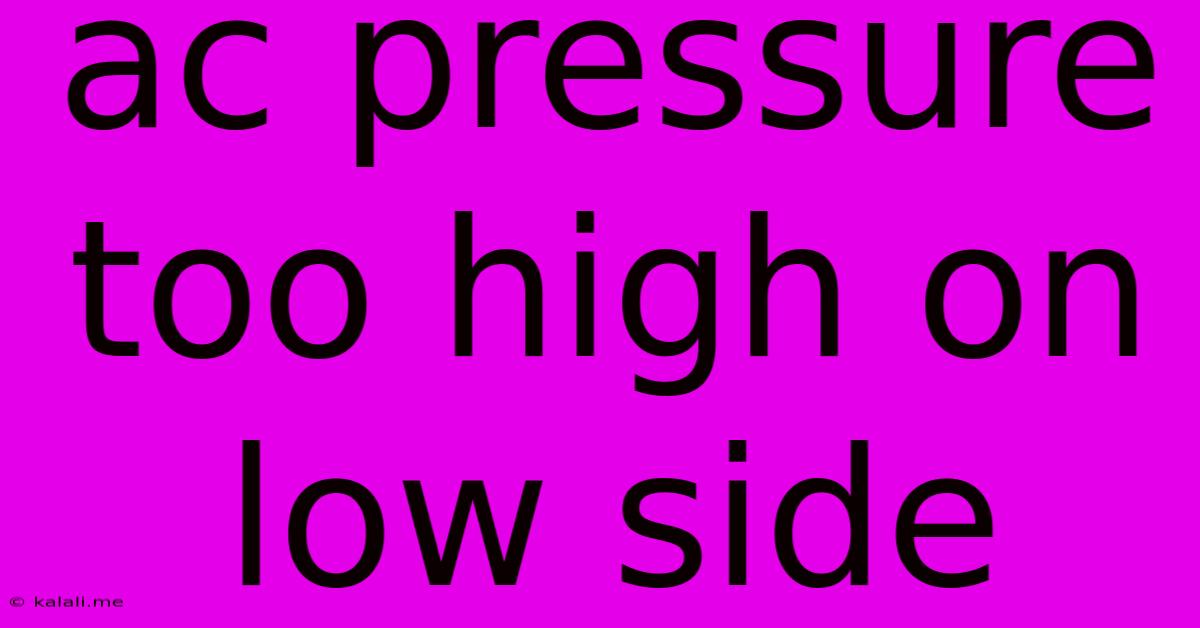Ac Pressure Too High On Low Side
Kalali
Jun 02, 2025 · 4 min read

Table of Contents
AC Pressure Too High on the Low Side: Troubleshooting and Solutions
Your air conditioning system's low-side pressure is significantly higher than normal? This isn't just an inconvenience; it signals a potential problem that could lead to compressor damage or system failure. This article will guide you through understanding the causes of high low-side pressure in your AC unit, troubleshooting steps, and potential solutions. Ignoring this issue can lead to costly repairs down the line.
High low-side pressure, unlike the more commonly discussed high high-side pressure, indicates a blockage or restriction in the refrigerant flow. This prevents the refrigerant from properly absorbing heat and can cause serious damage.
Understanding AC System Pressure
Before diving into the problem, it's crucial to understand the basic principles of AC pressure. Your AC system uses refrigerant, which circulates through a closed loop, undergoing changes in pressure and temperature. The low-side pressure is measured at the suction line, before the refrigerant enters the compressor. A normal low-side pressure is typically between 25 and 50 PSI, depending on the ambient temperature and refrigerant type. High low-side pressure, above this range, points to a problem.
Common Causes of High Low-Side AC Pressure
Several factors contribute to elevated low-side pressure. Let's examine some of the most frequent culprits:
-
Restricted Refrigerant Flow: This is often the primary cause. Obstructions in the evaporator, condenser, or refrigerant lines can significantly impede the flow, causing a pressure buildup on the low side. This can be due to debris, ice formation, or even kinks in the lines.
-
Overcharged Refrigerant: Adding too much refrigerant to the system is a common mistake. This increases pressure throughout the system, leading to high low-side readings.
-
Compressor Issues: A malfunctioning compressor can restrict refrigerant flow and contribute to high low-side pressure. A failing compressor may not be efficiently pulling refrigerant, creating a backlog.
-
Condenser Problems: A dirty or clogged condenser coil restricts heat dissipation, affecting the refrigerant's ability to condense and causing pressure imbalances.
-
Expansion Valve Problems: The expansion valve controls refrigerant flow into the evaporator. A malfunctioning expansion valve, whether stuck open or closed, can cause pressure imbalances. A restricted expansion valve is a frequent culprit in high low-side pressure scenarios.
Troubleshooting Steps
Diagnosing the root cause requires systematic troubleshooting. This is not a DIY job for the inexperienced, as improper handling of refrigerant can be dangerous. If you are not comfortable working with refrigerant, it's best to contact a qualified HVAC technician.
However, some basic checks can help point you in the right direction:
-
Visual Inspection: Carefully examine the system for any visible obstructions, leaks, or damage to the lines, condenser coil, or evaporator. Look for signs of ice buildup, which indicates restricted airflow.
-
Condenser Coil Cleaning: A dirty condenser coil can significantly impact efficiency. Clean the coil with a coil cleaning brush and a garden hose to remove debris.
-
Check for Leaks: Use leak detection equipment to identify any refrigerant leaks. Small leaks can lead to undercharging, but significant leaks will create a pressure imbalance.
-
Temperature Checks: Measure the temperature at different points in the system. Unusually high temperatures can pinpoint the location of the blockage.
Solutions
The solution depends entirely on the cause identified during troubleshooting. Do not attempt to add refrigerant without proper knowledge and equipment. Improper refrigerant charging can further damage the system. Solutions include:
-
Repairing or Replacing Damaged Components: If a damaged component (expansion valve, compressor, etc.) is identified, it will need to be repaired or replaced by a qualified technician.
-
Removing Obstructions: Cleaning the condenser coil, clearing debris from the lines, or fixing kinks are essential steps to restore proper refrigerant flow.
-
Correcting Refrigerant Charge: If the system is overcharged, a qualified technician must properly evacuate and recharge the system with the correct amount of refrigerant.
Preventing Future Issues
Regular maintenance is key to preventing high low-side pressure and other AC problems. This includes:
- Annual AC Inspections: Schedule annual inspections by a qualified technician to identify potential issues early on.
- Regular Condenser Coil Cleaning: Clean the condenser coil at least once a year, or more often in dusty environments.
- Proper System Operation: Avoid running the AC continuously at maximum capacity. Allow for adequate airflow around the unit.
High low-side AC pressure is a serious issue requiring prompt attention. While some basic checks can be performed, professional assistance from a qualified HVAC technician is usually necessary for accurate diagnosis and safe repair. Ignoring the problem can lead to significant damage and expensive repairs, so don't hesitate to seek professional help.
Latest Posts
Latest Posts
-
How To Kill Mold On Concrete
Jun 04, 2025
-
Gmail Settings Mark Mail Read On Server
Jun 04, 2025
-
Do Car Seats Have An Expiry Date
Jun 04, 2025
-
Dualshock 4 Bluetooth Pc Disconnects After Awhile
Jun 04, 2025
-
A Word For Someone Receptive To Learning
Jun 04, 2025
Related Post
Thank you for visiting our website which covers about Ac Pressure Too High On Low Side . We hope the information provided has been useful to you. Feel free to contact us if you have any questions or need further assistance. See you next time and don't miss to bookmark.